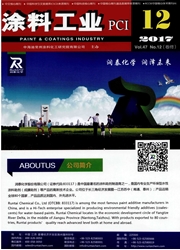

 中文摘要:
中文摘要:
摘要:通过抗菌测试为CT纳米催化剂筛选合适的基底材料、确定cT纳米催化剂添加量;使用激光共聚焦显微镜和扫描电子显微镜观察细菌生物膜形成状态及涂层微观形态;通过测定羟自由基(·OH)、超氧阴离子自由基(·O-2)、丙二醛(MDA)等活性氧(ROS)指标对其抗菌机理进行研究。结果表明:用无机硅胶粘合剂作基底材料的抗菌涂层具有更好的抗菌效果,当CT纳米催化剂在无机硅液体中的添加量为0.3g/L时,具有最好的抗菌效果,对大肠杆菌的抗菌率达到了40%-50%。激光共聚焦显微镜、扫描电镜下,可观察到含0.3g/L CT纳米催化剂的抗菌涂层对金黄葡萄球菌生物膜的形成具有明显的抑制作用。涂膜与大肠杆菌、金黄色葡萄球菌反应液中·O-2、·OH、MDA指标的测定结果表明,ROS生成和氧化应激在CT涂膜抗菌过程中起着关键作用,且不依赖光照条件。
 英文摘要:
英文摘要:
The different binder for CT catalyst has been investigated in terms of their anti- bacterial function, by which the proper dosage of CT catalyst is determined. The biofilm and microstructure of coating were observed by LSCM and SEM. The antibacterial mechanism is also discussed via the obtained ROS data (e.g., O-2, OH and MDA, etc.). The results show that an inorganic silicon paint (nanoglue) comprising 0. 3 mg/mL CT gives the highest effi- ciency (40~ 50 % reduction of E. coli population) compared to control samples. LSCM and SEM photos show that the CT-containing surface suppresses the development of S. aureus's biofilm. Study on antibacterial mechanisms of the CT-containing surface shows that ROS gen- eration and oxidative stress response in E. coli and S.aureus play an important role in the anti- bacterial process of the coated surface.
 同期刊论文项目
同期刊论文项目
 同项目期刊论文
同项目期刊论文
 期刊信息
期刊信息
